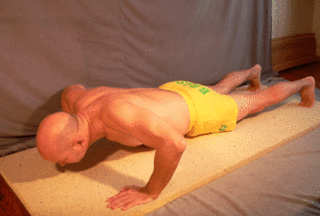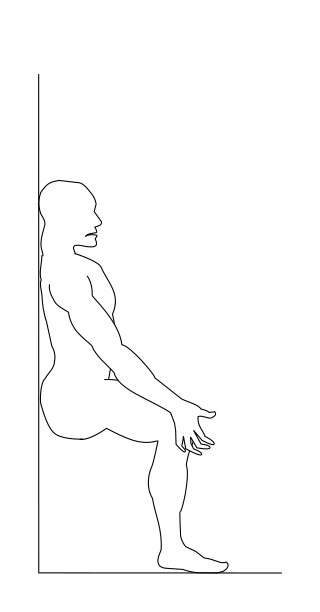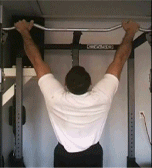This article needs additional citations for verification .(October 2017) |

The Roman chair is a piece of exercise equipment. It is mainly used for the lower back, but can also target the buttocks, hamstrings, and abdomen.
This article needs additional citations for verification .(October 2017) |

The Roman chair is a piece of exercise equipment. It is mainly used for the lower back, but can also target the buttocks, hamstrings, and abdomen.
Bodyweight can provide significant resistance, while additional weight held by the person exercising increases difficulty. Two actions are performed while doing hyperextensions on a Roman chair. The body is bent forward at the hips, lowering the body towards the floor. The body is then lifted to straighten the back again, to return to the start position and complete one repetition (see animation, above).
The Roman chair is also used to perform exercises for the abdomen. An exerciser lies supine with their hips supported on the rear (weight on the gluteus maximus) as they bend backward and lift themselves up with their rectus abdominis while stabilizing the pelvis with the hip flexors. If the pelvis moves during the exercise then the hip flexors will also be dynamic prime movers. [1]
A common exercise using the Roman chair for targeting the abdominal muscles is the "Roman chair sit-ups". It is an old-school exercise known to strengthen the belly. It can also strengthen some secondary stabilizer muscles in the core. [2]
An exercise more commonly referred to as the wall sit, an isometric movement to build strength in the quadriceps, may also be called the Roman chair. [3] It involves a person with their back against the wall, pushing into it using the action of knee extension. Even though it is called a "sit", the hips are actually not being held up by sitting on something. Rather, the body is held up via a combination of weight bearing on the feet and friction created with the wall by exerting pressure against it.[ citation needed ]
Another exercise called the "Roman chair squat" requires using the quadriceps dynamically.[ citation needed ] It similarly mimics a sitting motion without actually sitting down on something, and can be done on an apparatus similar to the aforementioned spinal exercises. This is similar to a "sissy squat".[ citation needed ]

The leg is the entire lower limb of the human body, including the foot, thigh or sometimes even the hip or buttock region. The major bones of the leg are the femur, tibia, and adjacent fibula. There are 60 leg bones in each leg.

Calisthenics or callisthenics is a form of strength training that utilizes an individual's body weight as resistance to perform multi-joint, compound movements with little or no equipment.

The bench press or chest press is a weight training exercise where a person presses a weight upwards while lying horizontally on a weight training bench. The bench press is a compound movement, with the primary muscles involved being the pectoralis major, the anterior deltoids, and the triceps brachii. Other muscles located in the back, legs and core are involved for stabilization. A barbell is generally used to hold the weight, but a pair of dumbbells can also be used.

The push-up is a common calisthenics exercise beginning from the prone position. By raising and lowering the body using the arms, push-ups exercise the pectoral muscles, triceps, and anterior deltoids, with ancillary benefits to the rest of the deltoids, serratus anterior, coracobrachialis and the midsection as a whole. Push-ups are a basic exercise used in civilian athletic training or physical education and commonly in military physical training. They are also a common form of punishment used in the military, school sport, and some martial arts disciplines to humiliate and its absence of use for equipment. Variations of push-ups, such as wide-arm push-ups, diamond push-ups target specific muscle groups and provide further challenges.

A squat is a strength exercise in which the trainee lowers their hips from a standing position and then stands back up. During the descent, the hip and knee joints flex while the ankle joint dorsiflexes; conversely the hip and knee joints extend and the ankle joint plantarflexes when standing up. Squats also help the hip muscles.

An isometric exercise is an exercise involving the static contraction of a muscle without any visible movement in the angle of the joint. The term "isometric" combines the Greek words isos (equal) and -metria (measuring), meaning that in these exercises the length of the muscle and the angle of the joint do not change, though contraction strength may be varied. This is in contrast to isotonic contractions, in which the contraction strength does not change, though the muscle length and joint angle do.

In weight training, a kettlebell is a cast-iron or cast-steel ball with a handle attached to the top, resembling a cannonball with a handle. It is used to perform many types of exercises, including ballistic exercises that combine cardiovascular, strength and flexibility training. Kettlebells are the primary equipment used in the weight-lifting sport of kettlebell lifting.
The good-morning is a weight training exercise. It is known as a good morning because of the movement in the erector spinae which resembles the bow that traditionally begins a schoolday in some East-Asian countries. The erector spinae muscles of the lower back work isometrically to keep the spine in an extended position while the hamstrings and gluteus maximus work isotonically to perform hip extension. Other muscles are involved in stabilizing weight on the back and maintaining balance.

The imaginary chair or wall sit is a means of exercise or punishment, where one positions themselves against a wall as if seated.
Abdominal exercises are a type of strength exercise that affect the abdominal muscles. Human abdominal consist of four muscles which are the rectus abdomens, internal oblique, external oblique, and transversus abdominis. When performing abdominal exercises it is important to understand the effects, functions, the types of exercises, and think about how to perform this exercise safely.

The following outline is provided as an overview of and topical guide to exercise:

The leg extension is a resistance weight training exercise that targets the quadriceps muscle in the legs. The exercise is done using a machine called the Leg Extension Machine. There are various manufacturers of these machines and each one is slightly different. The leg extension is an isolated exercise targeting one specific muscle group, the quadriceps. It should not be considered as a total leg workout, such as the squat or deadlift.

Bodyweight exercises are strength training exercises that use an individual's own weight to provide resistance against gravity. Bodyweight exercises can enhance a range of biomotor abilities including strength, power, endurance, speed, flexibility, coordination and balance. Such strength training has become more popular among recreational and professional athletes. Bodyweight training uses simple abilities like pushing, pulling, squatting, bending, twisting and balancing. Movements such as the push-up, the pull-up, and the sit-up are among the most common bodyweight exercises.
In kinesiology, core stability is a person's ability to stabilize their core. Stability, in this context, should be considered as an ability to control the position and movement of the core. Thus, if a person has greater core stability, they have a greater level of control over the position and movement of this area of their body. The body's core is frequently involved in aiding other movements of the body, such as running; thus it is known that improving core stability also improves a person's ability to perform these other movements.
Calf raises are a method of exercising the triceps surae, tibialis posterior, and peroneal muscles of the lower leg. The movement performed is plantar flexion, also called ankle extension.

A back extension is an exercise that works the lower back as well as the mid and upper back, specifically the erector spinae muscles. There are two erector spinae, one on either side of the spine, that run along its length. These are formed of three smaller muscles – spinalis, longissimus, and iliocostalis.

The leg raise is a strength training exercise which targets the iliopsoas. Because the abdominal muscles are used isometrically to stabilize the body during the motion, leg raises are also often used to strengthen the rectus abdominis muscle and the internal and external oblique muscles.

Street workouts are a physical activity performed in outdoor parks or public facilities. The movement behind street workouts became popular in Russia, Israel, Myanmar, Morocco, Uzbekistan, Eastern Europe, and the United States, especially in New York City, Los Angeles, Chicago, Philadelphia, Miami, Baltimore, Washington, D.C., and other urban East Coast neighborhoods. It is a combination of athletics, calisthenics, and sports. "Street workout" is a modern name for calisthenics in outdoor parks. There are also street workout teams and organized competitions for exercises such as pull-ups, chin-ups, push-ups, dips, rows, muscle-ups, sit-ups and squats. A street workout also involves static (isometric) holds such as the human flag, front lever, back lever, L-sit and planche.

Power training typically involves exercises which apply the maximum amount of force as fast as possible; on the basis that strength + speed = power. Jumping with weights or throwing weights are two examples of power training exercises. Regular weight training exercises such as the clean and jerk and power clean may also be considered as being power training exercises due to the explosive speed required to complete the lifts. Power training may also involve contrasting exercises such as heavy lifts and plyometrics, known as complex training, in an attempt to combine the maximal lifting exertions with dynamic movements. This combination of a high strength exercise with a high speed exercise may lead to an increased ability to apply power. Power training frequently specifically utilises two physiological processes which increase in conjunction with one another during exercise. These are deep breathing, which results in increased intra-abdominal pressure; and post-activation potentation, which is the enhanced activation of the nervous system and increased muscle fibre recruitment. Power training programmes may be shaped to increase the trainee's ability to apply power in general, to meet sports specific criteria, or both.